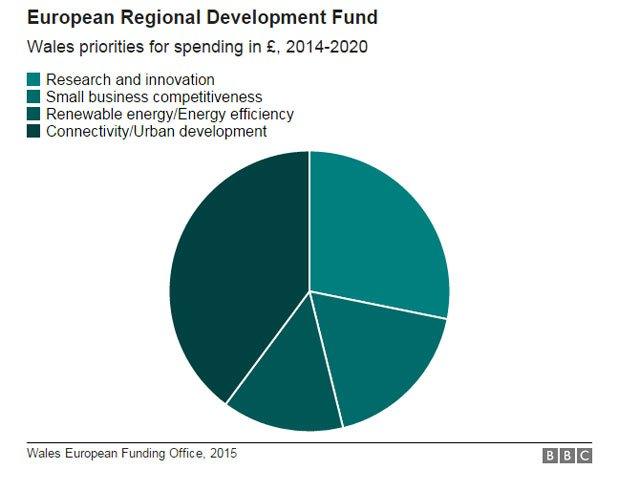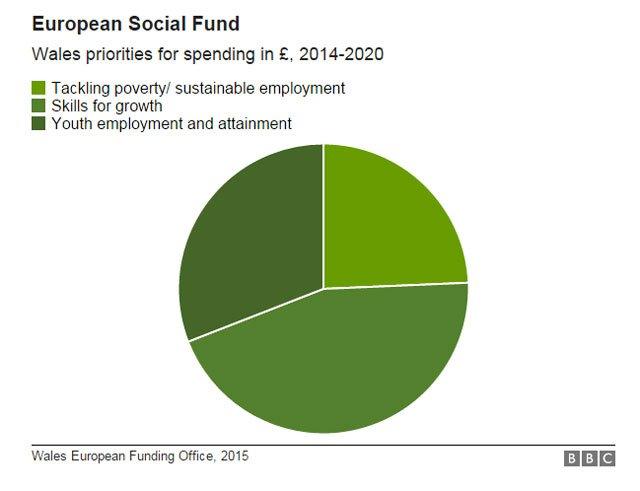What next for Wales' European funding?
- Published

Wales has had £4bn in structural funding from the EU since 2000 according the Welsh Government. That is set to continue until 2020.
The idea of the money is to help make the Welsh economy stronger and wealthier.
But how does it work?

This shows how Wales is divided into two areas which qualify for different levels of EU structural funding
Wales is divided into two areas: West Wales and the Valleys - which is made up of 15 local authorities - and east Wales, which covers seven council areas.
West Wales and the Valleys has the highest level of structural funding, known as convergence funding. It is for countries with a gross value added (GVA) less than three quarters of the EU's average.
The money is pledged in seven year periods. In theory it is spent in such a way that it is not needed again because the economy has become stronger and the country's GVA has grown to above three quarters of EU GDP.
West Wales and the Valleys has now been awarded the highest level of structural funding three times in a row, as has Cornwall, Liverpool and the Highlands and Islands of Scotland has had it twice.
That does not mean that Welsh GVA has not grown - rather it means that the average level of GVA across the EU has grown at a faster rate.
This means that West Wales and the Valleys still has a GVA less than 75% of the EU nations' average.
Structural funds from the EU must be match funded in some way or another.
The Wales European Funding Office determines which projects are given money.
However there are clear priorities for the money. For the next few years these are:

For European Regional Development fund (ERDF)
Research and innovation
Small/medium enterprises' competitiveness
Renewable energy/ energy efficiency - including improving developing marine energy
Connectivity and urban development - including congestion bottlenecks affecting the A40 and A55 and completing superfast broadband networks

For European Social Fund (ESF)
Tackling poverty through sustainable employment
Skills for growth
Youth employment and attainment.

Rhyl's harbour project received about £9m in European funding
Total European structural funding in Wales over 20 years
£1.5bn - 2000-2006
£1.8bn - 2007-2013
£1.89bn - 2014-2020
So what types of projects has the money funded?
EU funding in recent years has supported big flagship projects - particularly infrastructure, such as £40m towards Swansea University's new Bay Campus, external, nearly £4m towards the development of the Wales Coastal Path, external, £9m towards Rhyl's Foryd Harbour, external, as well as the dualling of the A465 Heads of the Valleys.
In the past it has included helped build Swansea's National Waterfront Museum and the new visitors' centre and cafe on Snowdon's summit.
But it also works on a much more local level, particularly in rural and poorer communities. In the last funding cycle, it was estimated the funding helped 290 projects and the creation of nearly 37,000 jobs.
Alan Shiers of Telynau Teifi Harps in Ceredigion was helped by EU support 12 years ago when the banks would not listen.
It was saving skills, creating jobs and protecting Welsh culture that won the argument for Telynau Teifi Harps , externalto get significant investment.
In 2004 it was awarded £1.1m - £670,000 from the EU's Objective One budget. The rest of the money was raised in the community by voluntary groups. It paid for an old school in Llandysul to be turned into workshops, for tools and machines. Six people now work there.
Alan Shiers, who set it up, has been making harps by hand for 40 years.
He does not want his skills to be lost when he no longer works but now he says those skills are being learnt for future generations with this community enterprise.
"It creates employment, the language stays, the culture - it's a reason for people to stay in the country and not have to leave for the cities."
"The banks weren't as interested in the community but Europe was," he added.
Crawford Mcleary is asked if his water sports business could have been set up without an EU grant
Cardigan Bay Watersports in New Quay was also helped with European money to get off the ground.
They were awarded £164,833 from the EU Objective One allocation for its community sea-skills training centre, more from Ceredigion County Council and now have three full time staff working between March and October.
They offer a range of water sports training to adults and children and business is strong.
As much as 80% of its turnover is in June, July and August.
Crawford Mcleary said it would have been impossible to find alternative funding to set up such a seasonal business without EU help.
He doubts banks would have supported the venture when it started due to its seasonal nature but he said it delivered "smiles, experiences, confidence improvement, customer satisfaction, participation in sport and contribution to the community".
Councillor Gethin James, who runs a cafe in Aberporth, says funding could still continue after Brexit
But others who support Britain leaving the EU said there is no reason that the money would still not come to poorer areas and British democracy would ensure it.
Councillor Gethin James, who owns a seaside cafe in Aberporth, said: "At the moment the Westminster government doesn't have to show its hand on that because the support is coming through it the European system - but let's not forget that's UK taxpayers money going in and we get less than half of it back to the UK.
"If we do pull out of the EU we're going to have to look at how we support poorer regions - not just in Wales but the UK as a whole."
The whole issue of EU structural funding, its impact on Wales and in particular west Wales and the Valleys is about more than "will we get it if we stay?" and "will we still get it if we leave?"
In an ideal world, surely Wales would not be eligible for the highest level of support reserved for the poorest nations of the EU?
But the vision of a Welsh economy so much stronger, that it is no longer poor enough to qualify for European funding is not being discussed much in this campaign.
Instead we hear those wanting to leave the EU arguing that the UK Government would have more money to give to areas like Wales.
Meanwhile those who want to remain talk as if they expect Wales to still be eligible after 2020.
At that level it becomes a very personal decision about who voters trust.